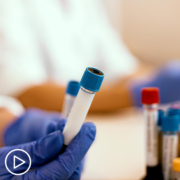What Are Treatment Options for Essential Thrombocythemia (ET) & Polycythemia Vera (PV)?
What Are Treatment Options for Essential Thrombocythemia (ET) & Polycythemia Vera (PV)? from Patient Empowerment Network on Vimeo.
When considering treatment options for essential thrombocythemia (ET) and polycythemia vera (PV), where do experts begin? Dr. Brady Stein details treatment considerations and how he determines the best approaches for ET and PV patients.
Dr. Brady Stein is a hematologist focusing on myeloproliferative neoplasms (MPNs) at the Robert H. Lurie Comprehensive Cancer Center of Northwestern University. Learn more about Dr. Stein, here.
Related Resources

|

|

|
Transcript:
Katherine:
Let’s start with essential thrombocythemia, or ET.
Dr. Stein:
So, I think the first thing is taking an inventory of symptoms, seeing how symptomatic the patient might be. Again, there are some patients who are asymptomatic or have few symptoms, and they were told of a high platelet count during a routine visit, so some patients can be observed if they have few symptoms, and especially if they fall into a lower vascular risk category.
So, symptom assessment first. Second, looking at vascular risk, and there are four categories of risk in in ET in terms of predicting the likelihood of a future blood clotting event. There’s a very low, low, intermediate and high risk group, and that’s based on a patient’s age, whether they’ve had a blood clot before, and the type of mutation they have. JAK2 mutations increase the risk of clotting.
So, if a patient falls into a higher-risk group – say they’re older than 60 with a JAK2 mutation or they’ve had a prior blood clot – those are patients who are generally treated more aggressively with cytoreduction.
And then, the other thing is aspirin. We often see aspirin given to all patients with ET, but not all patients with ET necessarily need it. The role of aspirin is actually a little less clear in ET. For a very low-risk patient, there’s a potential for more harm than benefit, especially if the patient lacks a JAK2 mutation. So, the evidence base to support aspirin for all ET patients is just not there; it’s evolving.
Katherine:
What about polycythemia vera, or PV?
Dr. Stein:
So, there are a few standards. It’s different – the aspirin question in PV is generally answered by randomized data from 16 years ago in 2004. It’s been shown that aspirin reduces the risk of clotting in PV patients, so, generally, we give low-dose aspirin to all patients. And, hematocrit control is really important.
At least, a goal of 45 percent is mandated in PV. And then, there are patients who might fall into a higher-risk category – older than 60 or have had a prior blood clot – they need something more. And then, I’d also emphasize that there are lower-risk patients who may not be traditional candidates for cytoreduction, but they could have symptoms that really interfere with quality of life, and symptoms alone can be the trigger to add something more to the phlebotomy and aspirin program.
Katherine:
What about things like interferon?
Dr. Stein:
So, interferons have been used in MPNs for decades and decades. So, a longstanding history with interferons. The issue has been tolerability.
These days, there’s a class called pegylated interferon that’s longer acting, and I think there’s been a lot more use, at least in the last 10 years, still much more in an academic setting than a community practice.
But, interferons have a pretty established role in MPNs, especially polycythemia vera, for sure in ET, less so in myelofibrosis.










